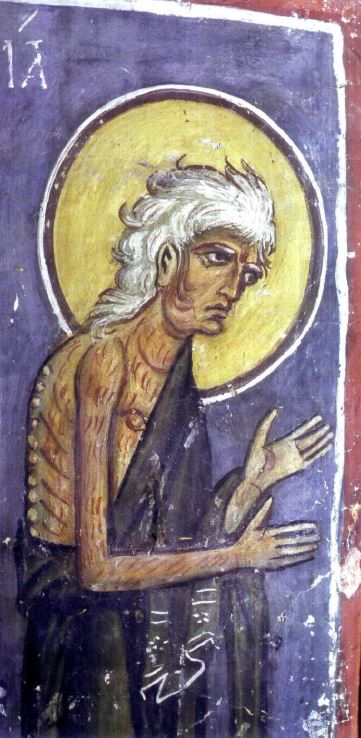The Affirmation of Gender in Byzantine Art through St. Mary of Egypt
DOI:
https://doi.org/10.56349/emblecat.240Keywords:
Mary of Egypt, Byzantine, gender, masculine, femenine, sainthood, holiness, anchoressAbstract
Byzantine pictorial cycles in churches follow a strict, well-planned theological symbolism. Not everyone can be a painter, nor can a painter paint whatever they wish. Nevertheless, orthodoxy gets questioned with paradigmatic figures such as Mary of Egypt: a woman saint represented in Byzantium as any other male anchorite saint. Her figure conveys questions of gender and sainthood, subverting the wrongful idea of Catholic binarism, which orthodoxy seems to dismantle with Mary of Egypt. Although the legitimacy of her figure is under scrutiny, Mary of Egypt is a significant subject of study for both artistic and social purposes. As Jeannete Lindblom states: “even the lives of purely fictional saints reveal a lot about society, religion, culture and so forth, and about the social and political history of the period”.
Downloads
References
Betancourt, R. (2020), Byzantine intersectionality: sexuality, gender, and race in the Middle Ages. Princeton University Press, Princeton, Nova Jersey. DOI: https://doi.org/10.1515/9780691210889
Bynum, C. (1991), Fragmention and Redemption: Essays on Gender and the Human Body in Medieval Religion. Nova York: Zone Books.
Bynum, C. (1987), Holy Feast and Holy Fast : The Religious Significance of Food to Medieval Women. University of California Press, Berkeley.
Bynum, C. (1982), Jesus as Mother: studies in the spirituality of the High Middle Ages. University of California Press, Berkeley.
Dumitrescu, I. (2018), “Desire: The Life of St Mary of Egypt”. A The Experience of Education in Anglo-Saxon Literature, editat per Irina Dumtriscu, 129-156. Cambridge University Press, Cambridge.
Franco, L. (2021), “Byzantine Lives: Discussing Nonbinary Sexuality, Gender and Race in Byzantium”, Harvard Theological Review 114 (4), p. 561-570. DOI: https://doi.org/10.1017/S001781602100033X
Jantzen, Grace M. (1995), Power, Gender and Christian Mysticism. Cambridge University Press, Cambridge.
Karras, R. (2017), Sexuality in Medieval Europe: doing unto others. New York Routledge, Londres. DOI: https://doi.org/10.4324/9781315269719
Lidov, A. (1991), The Mural Paintings of Akhtala. Nauka Publishers, Moscou.
Lindbblom, J. (2019), Women and públic space. Social codes and female presence in the Byzantine urban society of the 6th to the 8th centuries. Universitat de Helsinki: Helsinki, tesi doctoral.
Maguire, H. (1996), The Icons of Their Bodies: Saints and Their Images in Byzantium. Princeton University Press, Princeton, Nova Jersey.
Neville, L. (2019), Byzantine Gender. Amsterdam University Press, Amsterdam. DOI: https://doi.org/10.1515/9781641890175
Palacio, M. (2004), “¿Qué tiene para decirle M. Foucault al Cristianismo? Prólogo a una genealogia de genero de la moral sexual cristiana”, Pensamiento 60 (228). p. 413-422.
Purpura, A. (2020), “Innovating “traditional Women’s Roles: Byzantine Insights For Orthodox Christian Gender Discourse”, Modern Theology 36 (3). p. 641-661. DOI: https://doi.org/10.1111/moth.12538
Tatarchenko, S. (2012), “(trad.) Comunión de la Venerable María de Egipto» en la pintura monumental bizantina”, Vestnik PSTGU, Serie V 1 (7). p. 24–50.
Sofroni. Vie de Sainte Marie Égyptienne pénitente / par Sophrone. Suivie de Vie de Saint Syméon Stylite / par Théodoret de Cyr (trad. Arnauld d'Andilly), Montbonnot-St. Martin: Jérôme Millon, 1985.
Waldstein, M., Wisse, F. (eds.) (1995), The Apocryphon of John : synopsis of Nag Hammadi codices II,1; III,1; and IV,1 with BG 8502,2. Brill Publishers, Leiden. DOI: https://doi.org/10.1163/9789004439658_002
Watt, D. i Lees, C. (2011), “Age and Desire in the Old English Life of St Mary of Egypt: A Queerer Time and Place?”. A Middle-Aged Women in the Middle Ages, editat per Sue Niebryzdowski, 53-67. Woodbridge, Suffolk: D. S, Brewer. DOI: https://doi.org/10.1017/9781846157936.005

Downloads
Published
How to Cite
Issue
Section
License
Copyright (c) 2025 EMBLECAT, Estudis de la Imatge, Art i Societat

This work is licensed under a Creative Commons Attribution-NonCommercial-NoDerivatives 4.0 International License.




